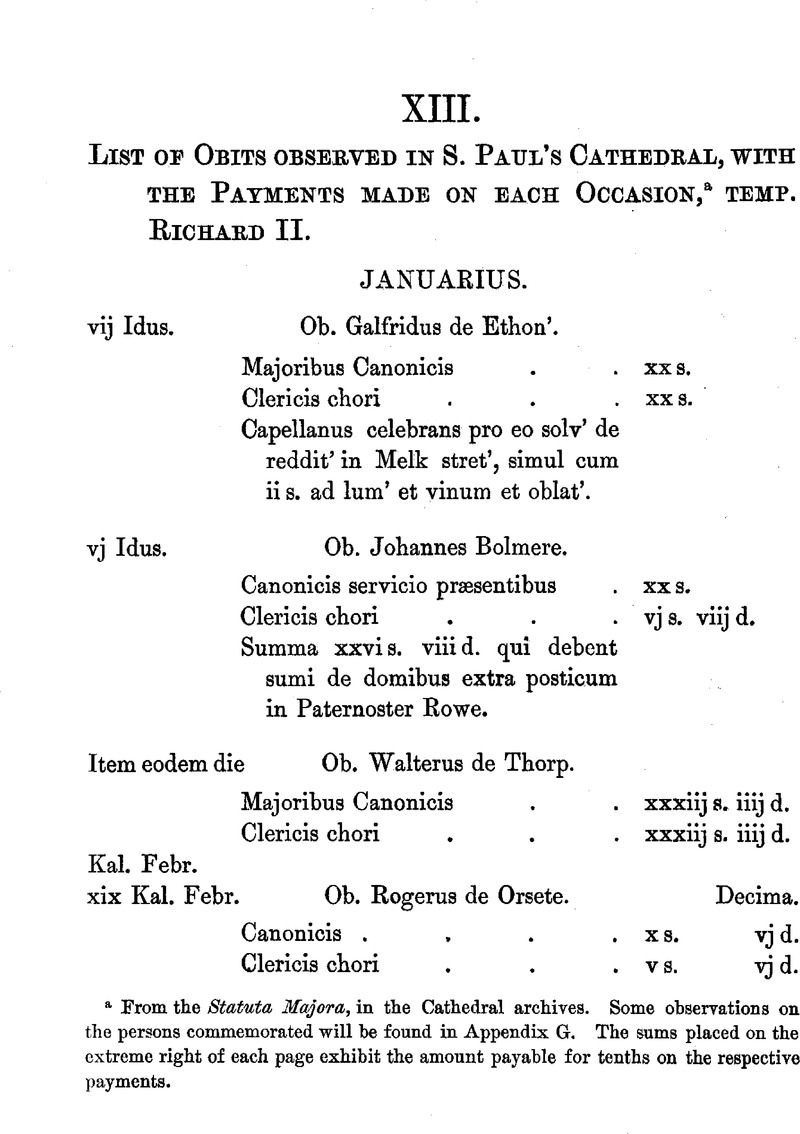No CrossRef data available.
Published online by Cambridge University Press: 24 December 2009

page 74 note a From the Statuta Majora, in the Cathedral archives. Some observations on the persons commemorated will be found in Appendix G. The sums placed on the extreme right of each page exhibit the amount payable for tenths on the respective payments.
page 75 note a S. Benet, Paul's Wharf. I have not extended the word ten'; the evidence of the document itself does not enable us to decide whether we should read tenemento or tenementis.
page 77 note a In the margin, in a different hand.
page 77 note b The brewery of the Cathedral. See many references to it in the Index of my Registrum.
page 77 note c This is a repetition.
page 77 note d Sic. These sums have been altered by a later hand.
page 78 note a Sic.
page 79 note a Inserted by a later hand.
page 79 note b Apparently written “Bernes” at first, but altered as above.
page 79 note c S. Nicholas ad Macellas, S. Nicholas at the Shambles, stood at the western end of Cheapside. It was pulled down in the time of Henry VIII.—Stow.
page 79 note d Here several lines are left blank, and “Gilberti Brewer” is written in the margin by another hand.
page 80 note a Sermon Lane, Little Carter Lane.
page 80 note b Originally “xvij s.” but “vij” is erased.
page 81 note a A statute relating to the houses “in atrio Sancti Pauli” will be found in the Registrum, 13.Google Scholar
page 81 note b Blank.
page 82 note a “Upon Paul's- Wharf-Hill, within a great Gate, and belonging to that Gate next to Doctors-Commons, are many fair Tenements; which in their Leases made from the Dean and Chapter go by the Name or Title of Camcra Dianœ, i.e. Diana's Chamber. So denominated from a spacious Building, that, in the Time of Henry the Second, stood where they are now standing. In this Camera, or arched and vaulted Structure, full of intricate Ways and Windings, this Henry tlte Second, as some Time he did at Woodstock, kept, or was supposed to have kept, that jewel of his heart, fair Rosamond: She, whom he there called Rosa mundi; and here, by the Name of Diana. And from thence had this House that Title.
“To this Day are Remains, and some evident Testifications of tedious Turnings and Windings, as also of a Passage under Ground, from this House to Castle Baynard. Which was, no doubt, the King's Way from thence to his Camera Dianœ, or the Chamber of his brightest Diana.”—Strype's Stow's Survey, i. 706.Google Scholar
The house is mentioned in the Cathedral Statutes as “Domus Dyanæ vel Rosamundæ.”—Registrum, 126, 127.Google Scholar
page 82 note b Tenens—obituum; these words are inserted by a later hand.
page 82 note c Inserted by a later hand.
page 83 note a The church is still called S. Mary Bassishaw.
page 83 note b This date is written faintly, but was intended to be rubricated, A few linos are left blank after the name.
page 83 note c Inserted by a later hand in the margin.
page 83 note d Dolittle's Alley was in Little Carter Lane.—London and its Enxirons.
page 84 note a Not rubricated.
page 84 note b Inserted in the margin by a later hand; see before.
page 84 note c Blank.
page 84 note d Not rubricated
page 85 note a Several lines left blank.
page 85 note b Old denes lane, or Eldeneslane, now called Warwick Lane.
page 86 note a Is this an error for marcas?
page 87 note a Blank.
page 88 note a The Introit of the fourth Sunday in Lent, Refreshment Sunday, Midlent Sunday: “Lætare Hiernsalem, et conventum facite omnes qui diligitis Dominum,” &c.—Sarum Missal, 211.Google Scholar
page 89 note a Blank.
page 91 note a The whole entry relating to this Obit has been inserted by a later hand.
page 92 note a Sic.
page 94 note a Now called Gutter Lane.
page 95 note a Inserted by later hands.
page 96 note a Inserted by a later hand.
page 98 note a No amounts are placed against this Obit.
page 98 note b Sic.
page 99 note a Sic.
page 99 note b Blank.
page 101 note a Archdeacon Hale (Domesday of S. Paul's, p. cxxxiGoogle Scholar) says that wastel bread was the best kind of wheaten bread, and that it was baked at S. Paul's on particular occasions, such as the Festivals of S. Paul and the Rogation Days. He quotes a passage from Chaucer's Prologue indicating the extravagance of the prioress in the case of her dogs:—
Of smale houndes had she, that she f edde
With rosted flesh and milk and wastel bread.
page 101 note b Allecia. Allecium or Allec, “pro Halec, pisciculus ad salsamenta idoneus.”—Ducange. Probably allecia rubea were red herrings.
page 102 note a So rubricated, but the direction in the margin is “xj Kal. Decemb.”
page 102 note b Sic.
page 105 note a These five sums in brackets are omitted in the original manuscript, and are supplied from the margin, where they are written by another hand.
page 105 note b Compare Domesday of St. Paul's, p. 162.Google Scholar